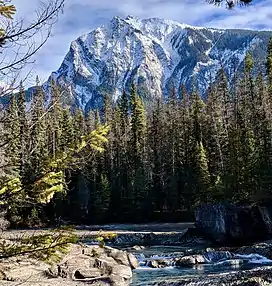| Mount Dennis | |
|---|---|
 West aspect of Mount Dennis | |
| Highest point | |
| Elevation | 2,549 m (8,363 ft)[1] |
| Prominence | 269 m (883 ft)[1] |
| Parent peak | Mount Stephen (3200 m)[1] |
| Listing | Mountains of British Columbia |
| Coordinates | 51°22′28″N 116°28′50″W / 51.37444°N 116.48056°W[2] |
| Naming | |
| Etymology | John Stoughton Dennis |
| Geography | |
 Mount Dennis Location of Mount Dennis in British Columbia  Mount Dennis Mount Dennis (Canada) | |
| Country | Canada |
| Province | British Columbia |
| District | Kootenay Land District |
| Protected area | Yoho National Park |
| Parent range | Park Ranges[1] |
| Topo map | NTS 82N8 Lake Louise[2] |
| Geology | |
| Age of rock | Cambrian |
| Type of rock | sedimentary rock |
| Climbing | |
| First ascent | 1887 James J. McArthur[1] |
Mount Dennis is a 2,549-metre (8,363-foot) mountain summit located three kilometres south of Field in Yoho National Park, in the Park Ranges of British Columbia, Canada. The nearest higher neighbor is Mount Stephen, 4.0 km (2.5 mi) to the northeast,[1] and Mount Burgess is six kilometres north on the opposite side of the Kicking Horse River valley. Mount Dennis has over 1,200-metre (3,900-foot) of vertical relief above Highway 1, the Trans-Canada Highway, which traverses the northwest foot of the mountain. Precipitation runoff from Mount Dennis drains into tributaries of the Kicking Horse River which in turn is a tributary of the Columbia River.
History
The first ascent of the mountain was made in 1887 by James J. McArthur of the Dominion Land Survey.[1]
The mountain was named in 1916 by Alexander MacKinnon Burgess for Lieutenant-Colonel John Stoughton Dennis (1820–1885), a Canadian surveyor who proposed the Dominion Land Survey system in 1869.[3][4]
The mountain's toponym was officially adopted in 1924 by the Geographical Names Board of Canada.[2]


Geology
Mount Dennis is composed of sedimentary rock laid down during the Precambrian to Jurassic periods. Formed in shallow seas, this sedimentary rock was pushed east and over the top of younger rock during the Laramide orogeny.[5]
Climate
Based on the Köppen climate classification, Mount Dennis is located in a subarctic climate zone with cold, snowy winters, and mild summers.[6] Winter temperatures can drop below −20 °C with wind chill factors below −30 °C. Weather conditions during winter make Mount Dennis one of the premier places in the Rockies for ice climbing.
Ice climbing routes
Ice climbing routes with grades on Mount Dennis[7]
- Carlsberg Column - WI5
- Guinness Gully - WI4
- Pilsner Pillar - WI6
- Cascade Kronenbourg - WI6
- Last Call - WI3
See also
References
- 1 2 3 4 5 6 7 "Mount Dennis". Bivouac.com. Retrieved 2019-02-19.
- 1 2 3 "Mount Dennis". Geographical Names Data Base. Natural Resources Canada. Retrieved 2019-02-19.
- ↑ "Mount Dennis". BC Geographical Names. Retrieved 2019-10-09.
- ↑ "Mount Dennis". cdnrockiesdatabases.ca. Retrieved 2019-10-09.
- ↑ Gadd, Ben (2008). Geology of the Rocky Mountains and Columbias.
- ↑ Peel, M. C.; Finlayson, B. L.; McMahon, T. A. (2007). "Updated world map of the Köppen−Geiger climate classification". Hydrol. Earth Syst. Sci. 11: 1633–1644. ISSN 1027-5606.
- ↑ "Mount Dennis Climbing". MountainProject. Retrieved 2019-10-09.
External links
- Weather forecast: Mount Dennis
- Parks Canada web site: Yoho National Park
- Dictionary of Canadian Biography: John Stoughton Dennis